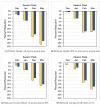Can a Two-Dose Influenza Vaccine Regimen Better Protect Older Adults? An Agent-Based Modeling Study
- PMID: 36366307
- PMCID: PMC9697266
- DOI: 10.3390/vaccines10111799
Can a Two-Dose Influenza Vaccine Regimen Better Protect Older Adults? An Agent-Based Modeling Study
Abstract
Older adults (age ≥ 65) are at high risk of influenza morbidity and mortality. This study evaluated the impact of a hypothetical two-dose influenza vaccine regimen per season to reduce symptomatic flu cases by providing preseason (first dose) and mid-season (second dose) protection to offset waning vaccine effectiveness (VE). The Framework for Reconstructing Epidemiological Dynamics (FRED), an agent-based modeling platform, was used to compare typical one-dose vaccination to a two-dose vaccination strategy. Primary models incorporated waning VE of 10% per month and varied influenza season timing (December through March) to estimate cases and hospitalizations in older adults. Additional scenarios modeled reductions in uptake and VE of the second dose, and overall waning. In seasons with later peaks, two vaccine doses had the largest potential to reduce cases (14.4% with February peak, 18.7% with March peak) and hospitalizations (13.1% with February peak, 16.8% with March peak). Reductions in cases and hospitalizations still resulted but decreased when 30% of individuals failed to receive a second dose, second dose VE was reduced, or overall waning was reduced to 7% per month. Agent-based modeling indicates that two influenza vaccine doses could decrease cases and hospitalizations in older individuals. The highest impact occurred in the more frequently observed late-peak seasons. The beneficial impact of the two-dose regimen persisted despite model scenarios of reduced uptake of the second dose, decreased VE of the second dose, or overall VE waning.
Keywords: adult; influenza; vaccine.
Conflict of interest statement
The authors KVW, MGK, and MGR declare no conflict of interest. RKZ has research grant funding from Sanofi Pasteur. LHH has done consulting with Sanofi Pasteur, GSK, Pfizer, and Merck without compensation. JVW serves on a Scientific Advisory Board for Quidel. The funders had no role in the design of the study; in the collection, analyses, or interpretation of data; in the writing of the manuscript; or in the decision to publish the results.
Figures


Similar articles
-
When to vaccinate for seasonal influenza? Check the peak forecast.Res Sq [Preprint]. 2024 Sep 9:rs.3.rs-4893237. doi: 10.21203/rs.3.rs-4893237/v1. Res Sq. 2024. PMID: 39315256 Free PMC article. Preprint.
-
Waning of Influenza Vaccine Protection: Exploring the Trade-offs of Changes in Vaccination Timing Among Older Adults.Clin Infect Dis. 2020 Apr 10;70(8):1550-1559. doi: 10.1093/cid/ciz452. Clin Infect Dis. 2020. PMID: 31257422
-
Compressed Influenza Vaccination in U.S. Older Adults: A Decision Analysis.Am J Prev Med. 2019 Apr;56(4):e135-e141. doi: 10.1016/j.amepre.2018.11.015. Epub 2019 Feb 14. Am J Prev Med. 2019. PMID: 30772149 Free PMC article.
-
Within-season influenza vaccine waning suggests potential net benefits to delayed vaccination in older adults in the United States.Vaccine. 2018 Sep 18;36(39):5910-5915. doi: 10.1016/j.vaccine.2018.08.007. Epub 2018 Aug 23. Vaccine. 2018. PMID: 30146403
-
Projecting influenza vaccine effectiveness: A simulation study.PLoS One. 2020 Nov 3;15(11):e0241549. doi: 10.1371/journal.pone.0241549. eCollection 2020. PLoS One. 2020. PMID: 33141871 Free PMC article.
Cited by
-
Bolstering influenza protection for older adults.Lancet Infect Dis. 2024 Oct;24(10):1064-1066. doi: 10.1016/S1473-3099(24)00403-1. Epub 2024 Jul 11. Lancet Infect Dis. 2024. PMID: 39004095 Free PMC article. No abstract available.
-
The Impact of the COVID-19 Pandemic on Influenza Vaccination Attitudes and Actions in Spain's Adult Population.Vaccines (Basel). 2023 Sep 23;11(10):1514. doi: 10.3390/vaccines11101514. Vaccines (Basel). 2023. PMID: 37896918 Free PMC article.
-
Estimated Burden of Influenza and Direct and Indirect Benefits of Influenza Vaccination.JAMA Netw Open. 2025 Jul 1;8(7):e2521324. doi: 10.1001/jamanetworkopen.2025.21324. JAMA Netw Open. 2025. PMID: 40668579 Free PMC article.
-
Modeling the Impact of COVID-19 Mitigation Strategies in Pennsylvania, USA.MDM Policy Pract. 2024 Jun 20;9(1):23814683241260744. doi: 10.1177/23814683241260744. eCollection 2024 Jan-Jun. MDM Policy Pract. 2024. PMID: 38911124 Free PMC article.
References
-
- Centers for Disease Control Flu Vaccination Coverage, United States, 2019–2020 Influenza Season. [(accessed on 25 May 2021)]; Available online: https://www.cdc.gov/flu/fluvaxview/coverage-1920estimates.htm.
-
- Centers for Disease Control and Prevention Influenza (Flu), Adults 65 & Over. [(accessed on 27 July 2022)]; Available online: https://www.cdc.gov/flu/highrisk/65over.htm#:~:text=In%20recent%20years%....
-
- Centers for Disease Control and Prevention Influenza (Flu), When is Flu Season. [(accessed on 27 July 2022)]; Available online: https://www.cdc.gov/flu/about/season/flu-season.htm.
-
- Ferdinands J.M., Gaglani M., Martin E.T., Monto A.S., Middleton D., Silveira F., Talbot H.K., Zimmerman R., Patel M. Waning Vaccine Effectiveness Against Influenza-Associated Hospitalizations Among Adults, 2015–2016 to 2018–2019, United States Hospitalized Adult Influenza Vaccine Effectiveness Network. Clin. Infect. Dis. 2021;73:726–729. doi: 10.1093/cid/ciab045. - DOI - PMC - PubMed
-
- Centers for Disease Control and Prevention Influenza Vaccination Coverage for Persons 6 Months and Older. [(accessed on 27 July 2022)]; Available online: https://www.cdc.gov/flu/fluvaxview/interactive-general-population.htm.
Grants and funding
LinkOut - more resources
Full Text Sources

